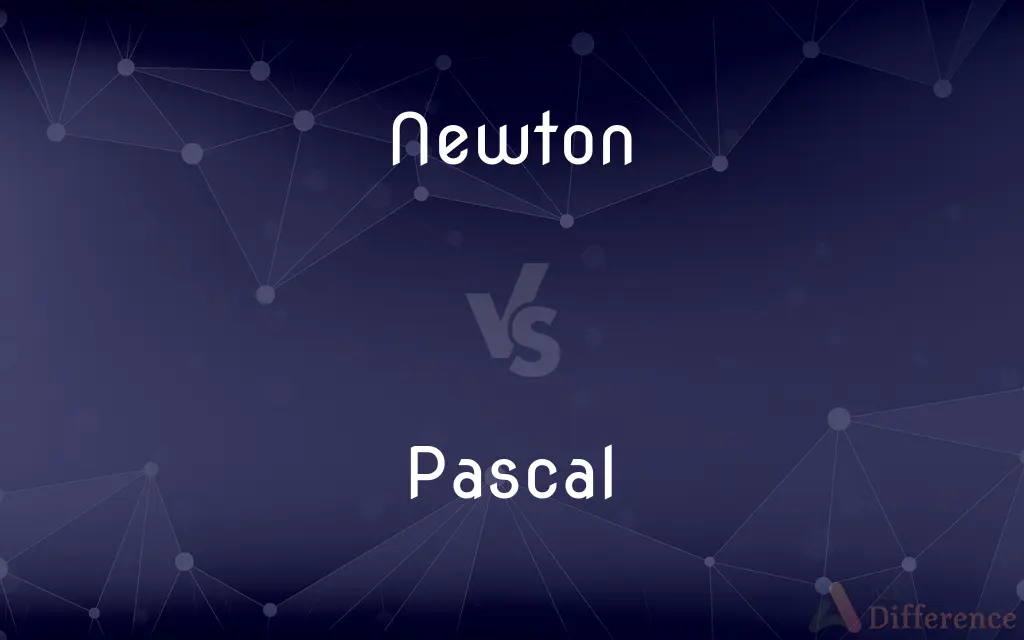Newton vs. Pascal — What's the Difference?
By Tayyaba Rehman & Fiza Rafique — Updated on March 29, 2024
Newton is unit of force in the SI, symbolized as "N," representing the force needed to accelerate 1 kg mass at 1 m/s². Pascal, symbolized as "Pa," is an SI unit of pressure, quantifying the force of 1 Newton applied over an area of 1 square meter.

Difference Between Newton and Pascal
Table of Contents
ADVERTISEMENT
Key Differences
The Newton (N) is the standard unit of force in the International System of Units (SI), defined as the force required to accelerate a one-kilogram mass by one meter per second squared. It's a fundamental unit in physics, named after Sir Isaac Newton to honor his work in classical mechanics, specifically his second law of motion. On the other hand, the Pascal (Pa) is the SI unit of pressure, equivalent to one Newton per square meter. It measures the force distributed over an area, named after Blaise Pascal, a French mathematician, physicist, and inventor known for his contributions to the understanding of fluid mechanics and hydrodynamics.
In practical terms, when measuring forces, such as the gravitational pull on an object, the unit of Newton is used. For example, the force exerted by an apple falling from a tree is quantified in Newtons. Whereas, Pascal is used when it's crucial to understand the pressure exerted on surfaces, such as the atmospheric pressure on Earth or the stress on a structural element of a building.
The distinction between Newton and Pascal highlights their applications in different contexts: Newton is solely concerned with force, while Pascal deals with how that force is distributed over an area. This difference is crucial in fields ranging from engineering, where the strength of materials under different pressures is key, to meteorology, where air pressure measurements inform weather predictions.
While both units are essential in physics and engineering, their usage depends on the aspect of a physical situation being measured. Understanding the force involved in a scenario requires Newtons, but understanding the impact of that force over an area necessitates Pascals. This delineation between force and pressure is fundamental in designing, analyzing, and understanding systems and structures in the physical world.
In summary, while the Newton and Pascal measure different physical quantities—force and pressure, respectively—they both play critical roles in the sciences. Their distinction not only underscores the diversity of physical phenomena but also illustrates the specificity required in scientific measurement and analysis.
ADVERTISEMENT
Comparison Chart
Definition
Unit of force.
Unit of pressure.
Formula
1 N = 1 kg·m/s²
1 Pa = 1 N/m²
Named After
Sir Isaac Newton.
Blaise Pascal.
Application
Measures the force acting on an object.
Measures the force exerted per unit area.
Significance
Essential in dynamics and mechanics.
Crucial for understanding fluid dynamics and stress in materials.
Compare with Definitions
Newton
Measures the magnitude of force.
A 10 N force is applied to push a box across the floor.
Pascal
SI unit of pressure.
Standard atmospheric pressure is about 101,325 Pascal.
Newton
Unit of force in the SI system.
The force required to accelerate a 1 kg mass at 1 m/s² is 1 Newton.
Pascal
Used in fluid dynamics and material science.
Studying water flow through a pipe involves calculations in Pascals.
Newton
Used in physics and engineering.
Calculating the net force on a bridge requires understanding the Newtons involved.
Pascal
Essential in meteorology for weather prediction.
A sudden drop in atmospheric pressure, measured in Pascal, can indicate an approaching storm.
Newton
Integral to dynamics and mechanics.
The engine exerts a force of 500 Newtons to move the car.
Pascal
Measures force distribution over area.
The hydraulic press applies pressure of 50,000 Pascal evenly across its surface.
Newton
Represents force needed for acceleration.
A rocket needs millions of Newtons of thrust to overcome Earth's gravity.
Pascal
Indicates stress on materials.
The structural integrity of a building is tested at several thousand Pascals.
Newton
The SI-derived unit of force required to accelerate a mass of one kilogram one meter per second per second, equal to 100,000 dynes. See Table at measurement.
Pascal
Abbr. Pa A unit of pressure equal to one newton per square meter.
Newton
In the International System of Units, the derived unit of force; the force required to accelerate a mass of one kilogram by one metre per second per second. Symbol: N.
Pascal
Pascal A programming language that was specially designed to support structured programming.
Newton
English mathematician and physicist; remembered for developing the calculus and for his law of gravitation and his three laws of motion (1642-1727)
Pascal
In the International System of Units, the derived unit of pressure and stress; one newton per square metre. Symbol: Pa.
Newton
A unit of force equal to the force that imparts an acceleration of 1 m/sec/sec to a mass of 1 kilogram; equal to 100,000 dynes
Pascal
A unit of pressure equal to one newton per square meter
Pascal
French mathematician and philosopher and Jansenist; invented an adding machine; contributed (with Fermat) to the theory of probability (1623-1662)
Pascal
A programing language designed to teach programming through a top-down modular approach
Common Curiosities
Can you convert Newtons to Pascals directly?
Direct conversion isn't applicable since they measure different quantities, but the relationship between force and pressure involves the area over which the force is distributed.
What does Pascal measure?
Pascal measures pressure, defined as the force of one Newton applied over an area of one square meter.
Why is the unit of force named after Newton?
It's named after Sir Isaac Newton in recognition of his work on classical mechanics, especially his formulation of the second law of motion.
How do engineers use Newtons and Pascals in design?
Engineers use Newtons to calculate forces acting on structures and Pascals to assess the pressure those structures can withstand.
What is a Newton and what does it measure?
A Newton is the SI unit of force, measuring the force required to accelerate a mass of one kilogram by one meter per second squared.
What are practical applications of Pascals?
Pascals are used in measuring tire pressure, atmospheric pressure, and stress on structural elements in engineering.
Is atmospheric pressure measured in Newtons or Pascals?
Atmospheric pressure is measured in Pascals, as it represents the force exerted by the atmosphere over a unit area.
What significance does Blaise Pascal have in the context of pressure?
Blaise Pascal contributed significantly to fluid mechanics and hydrodynamics, and the unit of pressure, Pascal, is named in his honor.
How are Newtons used in everyday life?
Newtons can be used to quantify the force exerted by objects or required to perform tasks, like lifting weights or pushing furniture.
How does the concept of Pascal apply in weather forecasting?
Changes in atmospheric pressure, measured in Pascals, help meteorologists predict weather changes, such as storms.
Can the pressure exerted by a fluid be measured in Newtons?
The force exerted by a fluid can be measured in Newtons, but the pressure it exerts is quantified in Pascals.
Why is understanding pressure in Pascals important in fluid dynamics?
In fluid dynamics, Pascals help in analyzing how fluids exert pressure on surfaces and within themselves, affecting flow and behavior.
What role does the unit of Newton play in vehicle dynamics?
In vehicle dynamics, Newtons measure the forces acting on the vehicle, including thrust, drag, and weight, crucial for design and performance analysis.
What is the relationship between force and pressure?
Force, measured in Newtons, when distributed over an area, results in pressure, measured in Pascals.
Share Your Discovery

Previous Comparison
Podiatrist vs. Podologist
Next Comparison
Arrearage vs. ArrearsAuthor Spotlight
Written by
Tayyaba RehmanTayyaba Rehman is a distinguished writer, currently serving as a primary contributor to askdifference.com. As a researcher in semantics and etymology, Tayyaba's passion for the complexity of languages and their distinctions has found a perfect home on the platform. Tayyaba delves into the intricacies of language, distinguishing between commonly confused words and phrases, thereby providing clarity for readers worldwide.
Co-written by
Fiza RafiqueFiza Rafique is a skilled content writer at AskDifference.com, where she meticulously refines and enhances written pieces. Drawing from her vast editorial expertise, Fiza ensures clarity, accuracy, and precision in every article. Passionate about language, she continually seeks to elevate the quality of content for readers worldwide.













































